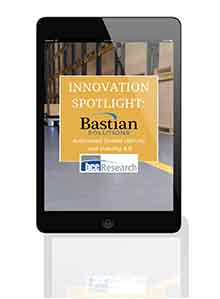Innovation Spotlight: Bastian Solutions: Automated Guided Vehicles and Industry 4.0
Picture an extremely busy factory turning out hundreds of SUVs each day...with not a single human being onsite. No workers on the line, no managers keeping watch, no drivers behind the wheels of forklifts or trucks. No one.
The concept of Industry 4.0 understandably scares a lot of folks. But keeping historical perspective is a useful way to remain calm-even optimistic about the matter. All four industrial revolutions have occurred over a very short period of human history. A drastically simplified summary is as follows: The first revolution was steam and water power, the second was railways and electricity, the third was the digital revolution—and here we are in the midst of the fourth, largely defined by smart technology, machine-to-machine learning and the internet of things (IoT).
With so many moving components of Industry 4.0, it's helpful to examine just one specific component of Industry 4.0: The automated guided vehicle, or AGV. This is a type of industrial robot mainly controlled by a computer. These are typically material handlers, configured as forklifts, small trucks or flatbeds. They typically feature such capabilities as automatic navigation, multi-sensor control and network interaction. The most important use of AGVs in production or manufacturing is to load and carry raw materials and components.
For an inside look at AGVs and how they are powering Industry 4.0, BCC sat down with Michael Marcum, Manager of Engineering, Autonomous Vehicles at Bastian Solutions, a Toyota Advanced Logistics Company.

